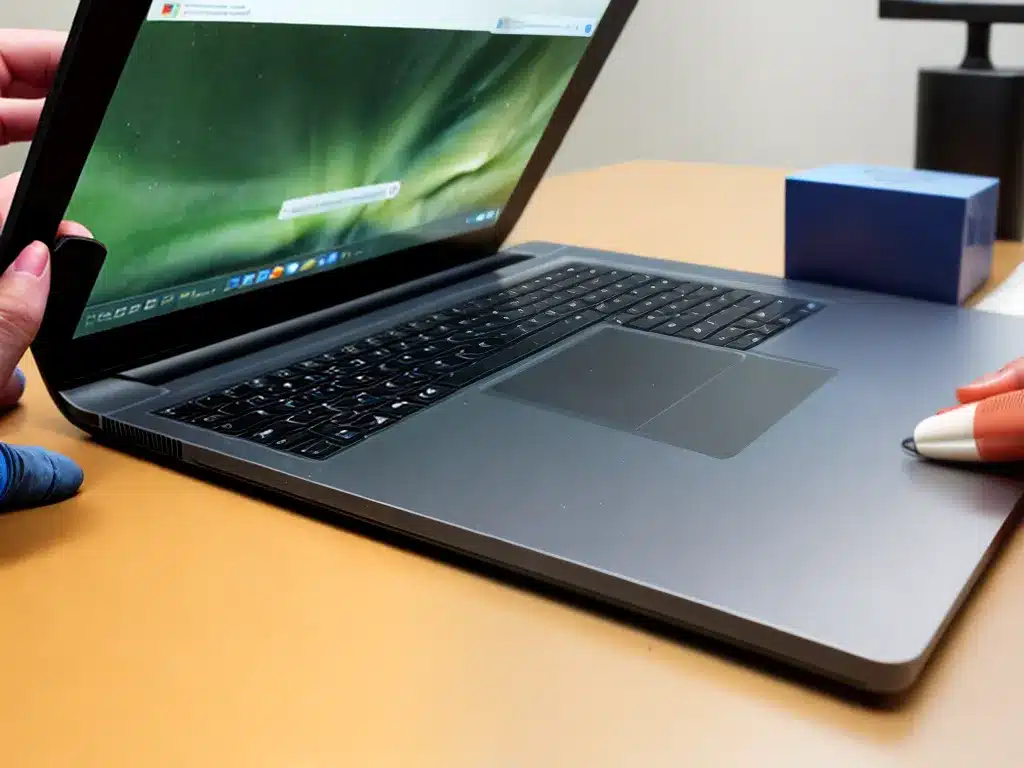
Troubleshoot The Issue
The first step when dealing with a faulty laptop touchpad is to troubleshoot and identify the exact issue. Here are some common touchpad problems and things to check:
Touchpad Not Working At All
- Make sure the touchpad is enabled in your laptop’s settings. There may be a keyboard shortcut (Fn + F key) or a setting in the BIOS to toggle the touchpad on/off.
- Check if the touchpad drivers are up to date. Go to the manufacturer’s website and download the latest drivers.
- If the touchpad works in BIOS but not in Windows, it could be a driver issue. Uninstall/reinstall the drivers.
Touchpad Not Scrolling
- Try scrolling with two fingers instead of one. Most modern touchpads need two-finger scrolling.
- Check if tap-to-click and other gestures are enabled in the touchpad settings.
Touchpad Cursor Jumping Around
- Make sure there is nothing accidentally touching the touchpad like your palm when typing.
- Try adjusting the touchpad sensitivity settings if available.
- Update the drivers. Faulty drivers can cause jumping cursor.
Touchpad Not Precise or Laggy Cursor
- Adjust the touchpad sensitivity settings in Control Panel.
- Clean the touchpad gently with a dry cloth in case of dirt buildup.
- Update the drivers to fix any software/firmware issues.
Software Troubleshooting
If hardware issues are ruled out, try these software troubleshooting steps:
- Uninstall and reinstall the touchpad drivers.
- Rollback to older driver version if issues started after an update.
- Disable power management for the touchpad device in Device Manager.
- Turn off any third party touchpad enhancement software.
- Do a clean boot to check if any third party app is interfering.
- Try a Windows restore point prior to when the issue started.
Always backup data before troubleshooting in case recovery or reset is required.
Hardware Troubleshooting
If the touchpad still has issues after software troubleshooting, it could be a hardware fault:
- Check the touchpad cables for any loose connection or damage.
- Inspect the touchpad for any physical damage, debris stuck under it.
- Try reseating the touchpad cables.
- If you have the tools, dismantle and check the touchpad button/sensors for any issues.
Take proper safety precautions when opening up the laptop.
If there is confirmed hardware damage, the touchpad may need replacement. Refer service manual for model-specific repair steps.
When To Avoid DIY Repair
While many touchpad issues can be fixed with basic troubleshooting, avoid DIY repair in these cases:
- The laptop is under warranty – contact manufacturer support.
- Issue is clearly due to faulty hardware like broken touchpad button.
- Repair involves dismantling the entire laptop.
- You don’t have the required tools and technical skill.
Physical damage can get worse with improper handling. It’s better to get help from a trained technician for complex repairs.
Finding The Right Repair Shop
If you need to take your laptop to a repair shop, here are some tips to find a reliable one:
- Search for shops that specialize in laptop and touchpad repairs. Avoid general electronic repair shops.
- Check online reviews and feedback from previous customers.
- Ask about their experience with similar touchpad repairs.
- Get a cost estimate in writing before handing over your laptop.
- Opt for shops that use original parts from the manufacturer.
- Make sure they offer a warranty on their workmanship.
Doing the due diligence will help you avoid shops that may further damage your laptop or overcharge for low quality work.
Preventing Future Touchpad Issues
Here are some tips to keep your laptop touchpad working well for longer:
- Avoid using sharp objects around the touchpad.
- Keep the touchpad clean and dry.
- Be gentle while using the touchpad buttons / tapping.
- Update touchpad drivers when new versions are available.
- Adjust sensitivity settings to your comfort level.
- Turn off the laptop before cleaning the touchpad.
- Use a touchpad protector skin if available for your model.
Following these usage best practices will greatly reduce the chances of wear and tear issues with your laptop’s touchpad.
When To Replace The Touchpad
If you have tried all the software and hardware troubleshooting steps but the touchpad still does not work properly, replacement may be necessary. Here are some signs it is time to replace the touchpad:
- Repeated issues even after driver updates, reinstalls, etc.
- Visible hardware damage like cracked touchpad casing, separated button, etc.
- Mechanical issues like sticky/unresponsive buttons, cursor drift.
- Older laptop with touchpad that’s just worn out over time.
Always consult service manual to buy the correct replacement touchpad for your laptop model. Installation is tricky and will likely require soldering – best left to experienced repair shops.
While having a faulty touchpad can be frustrating, following a methodical troubleshooting approach and taking preventive care will help minimize issues with your laptop’s touchpad. Prompt repair or replacement when required will get you back to an enjoyable touchpad experience.












